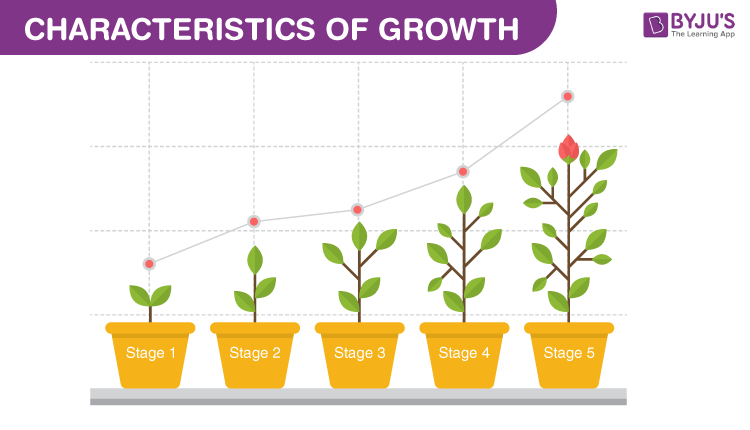From a biological perspective, the terms “growth” and “development” cannot be used interchangeably:
- Growth refers to the increase in mass and size of a body or organs. It typically occurs through the multiplication of cells and an increase in intracellular substance
- Development refers to the physiological and functional maturation of the organism. It also refers to the increase in capacity and skill to effectively function.
Growth and Development

Growth takes place all through the lifetime, but variably. In the case of humans, the rate of growth is faster until maturity. After attaining maturity, growth is gradual and slows down before it completely ceases.
Morphogenesis is the process where an organism is “shaped” by embryological factors such as the differentiation of cells, tissues and the development of organs and subsequent organ systems according to genetic “blueprint” of particular organism.
Types of Growth
We shall focus on the types of grwith seen in plants:
- Primary and Secondary Growth: The mitotic divisions in meristematic cells at the root and shoot apex hikes the length of the plant. This is called Primary Growth while Secondary meristem, which results in an increased diameter of the plant is known as Secondary Growth.
- Vegetative Growth: The growth in plants before flowering is known as vegetative growth and includes the formation of leaves, branches, and stems.
- Reproductive Growth: In this stage, the plants begin to flower which is a reproductive member of the plant.
Characteristics of Growth
Plants exhibit the ability to grow throughout their life. It is because of the presence of meristems at particular locations on the body and meristems have the capability to divide and self-perpetuate.
Growth is measurable. Growth is the consequence of the increase in protoplasm and this rise is not easy to measure. Growth is measured by different methods such as the rise in dry weight, the number of cells, volume, hike in fresh weight or volume.
The figure below shows the position of root apical meristem, vascular cambium and shoot apical meristem. The arrows show the growth direction of organs and cells.

The growth of plants is classified into three phases:
Formative Phase: The division of cells in the growth of plants is the most basic event. Every cell results in the division of cells that existed before. Mitosis is a kind of cell division that occurs during growth and involves both qualitative and quantitative division of the cells.
This division takes place in two steps:
First, the division of the nucleus which is called karyokinesis and division of cytoplasm known as cytokinesis. An increased number of cells are carried in higher plants on meristematic location and some daughter cells retain this meristematic occurrence while some enter the next phase of the growth, called the phase of cell enlargement.
Cell Differentiation and Cell Enlargement: At this stage, the size of organs and tissues increases and this occurs by the formation of Protoplasm, developing vacuoles, hydration and then integrating the new cell wall to make it thicker and permanent.
Cell Maturation: The enlarged cells at this stage acquire specific forms and sizes based on their role and location. Hence, various cells are differentiated from complex and simple tissues that perform different functions.
Factors Affecting Growth
Hormones in animals and Growth regulators help plants to grow steadily. Let’s discuss some of the factors affecting growth in various living beings. It would be convenient if we divide these factors into two broad categories, namely – Internal and External Factors.
External Growth Factors
- Light – Light is one of the most crucial components of photosynthesis in plants.
- Temperature – Every organism needs a suitable temperature to survive, to grow, to develop various tissues and organs, and also to reproduce.
- Water – Plants absorb water through their roots and use it for photosynthesis and other biochemical processes.
- Mineral Nutrients – Other than light, water, and a perfect temperature, organisms need special nutrients to support their food-making process and metabolism, which ultimately boosts growth in them.
Internal Growth Factors
In humans, the Growth Hormone is known as Somatotropin. Plants also contain such hormones, namely – Auxins, Gibberellins, Cytokinins, Ethylene, Abscisic acid. These are also called plant growth regulators.
Register with BYJU’S to learn more about Growth and Development or other related topics.

I really love it, very conducive and interesting
Nice and lovely
Very good and easily understood